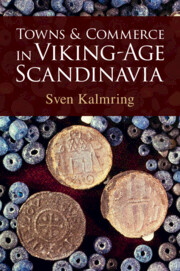Book contents
- Towns and Commerce in Viking-Age Scandinavia
- Additional material
- Towns and Commerce in Viking-Age Scandinavia
- Copyright page
- Epigraph
- Contents
- Plates
- Figures
- Maps
- Acknowledgements
- Abbreviations
- Maps
- 1 Introduction
- 2 The Viking-Age Town
- 3 The Viking World
- 4 Cult, Jurisdiction and Markets
- 5 Local Society and Viking-Age Towns
- 6 An Urbanisation Based on Harbours
- 7 Jurisdiction and Taxes
- 8 Free Trade within Narrow Boundaries
- 9 Special Economic Zones of Their Time
- 10 Development after the Inception Phase
- 11 Discussion: Hedeby’s Abandonment and the Foundation of Slesvig
- 12 Summary and Conclusions
- References
- Index
- Plate Section
4 - Cult, Jurisdiction and Markets
Things and Regional Fairs at Traditional Centres of Power
Published online by Cambridge University Press: 04 January 2024
- Towns and Commerce in Viking-Age Scandinavia
- Additional material
- Towns and Commerce in Viking-Age Scandinavia
- Copyright page
- Epigraph
- Contents
- Plates
- Figures
- Maps
- Acknowledgements
- Abbreviations
- Maps
- 1 Introduction
- 2 The Viking-Age Town
- 3 The Viking World
- 4 Cult, Jurisdiction and Markets
- 5 Local Society and Viking-Age Towns
- 6 An Urbanisation Based on Harbours
- 7 Jurisdiction and Taxes
- 8 Free Trade within Narrow Boundaries
- 9 Special Economic Zones of Their Time
- 10 Development after the Inception Phase
- 11 Discussion: Hedeby’s Abandonment and the Foundation of Slesvig
- 12 Summary and Conclusions
- References
- Index
- Plate Section
Summary
In their article Assembly Sites for Cult, Markets, Jurisdiction and Social Relations, Nørgård Jørgensen et al. (2010) argued for similarities between the large pit house sites of the Viking Age and the early modern period’s so-called church towns (Swd. kyrkstäder) in northern Sweden. Church towns are large agglomerations of occasionally inhabited cabins gathered around churches that were used for gatherings during major religious festivals in otherwise sparsely populated areas. In addition to baptisms, weddings and funerals, these gatherings simultaneously provided one of the few opportunities during the year for parliament meetings, tax collection, jurisdiction, market trade at fairs and even social events (Nørgård Jørgensen et al. 2010: 99). Based on these activities, the authors argued for a reinterpretation of larger Viking-age pit house agglomerations as possible temporary accommodation for family groups attending seasonal assemblies (things). Even more important in this context is that religious and judicial assemblies in sparsely populated societies were important social events, where a large gathered crowed likewise engaged in trade and exchange.
- Type
- Chapter
- Information
- Towns and Commerce in Viking-Age Scandinavia , pp. 29 - 49Publisher: Cambridge University PressPrint publication year: 2024

